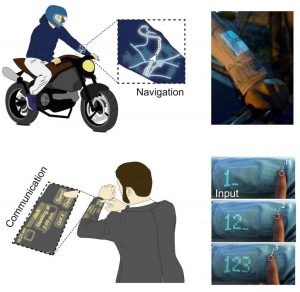 By Annisa Essack
By Annisa Essack
16:04:2021
Imagine a piece of fabric working exactly like your smartphone? Incredulous, right?!
Well, a team of Chinese scientists have developed a fabric that does exactly that, with the ability to have applications in communications, navigation, healthcare, and safety.
Inexpensive, the futuristic material could be in shops as early as December 2021. Hi-tech garments made from fabric could improve safety for emergency responders, cyclists, and motorists. The material turns an ordinary jacket into a touch screen and a quick brush on a sleeve could display a ‘textile map’ on their arm, instantly.
Wearable technology has been researched for years and there have been many successes but creating large displays integrated with functional systems has proved challenging. But researchers at Fudan University in Shanghai overcame the problem with a display fabric almost 20 feet long and 10 inches wide. Powered by solar energy, it combines conductive and luminescent fibres with cotton.
Professor Huisheng Peng, described the new electronic textile, “The cloth is flexible, breathable, and durable—making it ideal for the real world.”
Experiments performed shows that the electronic textile worked as a navigation tool showing an interactive map. It also performed communications by sending or retrieving messages via a Bluetooth connection with a smartphone. According to Prof. Peng, the display is produced by illuminating units that form where the conductive and luminescent fibres meet at contact points in the woven fabric.

The fabric is durable as it survived 1000 cycles of bending, stretching, and pressing and the brightness remained after 100 cycles of washing and drying. This is a useful attribute for the fabric. Peng says, “Conventional solid-state materials are not readily compatible with textiles because they struggle to withstand the natural deformation that occurs when fabrics are worn and washed.”
The potential for this innovation is vast in both the public and private sector. The team even envisions this being able to convert brain waves into signals on the clothes, which would be useful for people unable to speak.
With the addition of more applications, it is expected to shape the next generation of electronic communication tools.







0 Comments